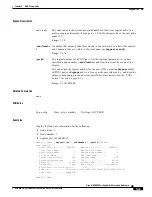
5-64
Cisco MGX 8850 Routing Switch Command Reference
Release 2.0, Part Number 78-10467-04 Rev C0, October 2001
Chapter 5
PNNI Commands
dsppnni-inducing-uplink
dsppnni-inducing-uplink
Display PNNI Inducing Uplink
—
display the PNNI inducing uplink database.
The dsppnni-inducing-uplink command displays the uplink-inducing database. The only application of
dsppnni-inducing-uplink is debugging.
Note
This command applies to multi-peer groups only, so it has no purpose in the current release.
The display shows:
•
Child node index number
•
Token (if configured)
•
Uplink node ID—the ID of the node
•
Uplink ATM address
•
Uplink peer group ID
•
Routing metrics of the uplink
The child node number is the number of a node at a lower level (as shown by dsppnni-node-list) from
which the uplink comes. The child port ID is the local port ID of the child node from which the uplink
comes. You can see the details of this uplink by executing dsppnni-idb. (In the display for dsppnni-idb,
the child node index is the local node number.)
The uplink node or upnode is the node at the upper end of the uplink. It is the neighboring peer of the
ancestor of the node from which the uplink originates.
The extent of the dsppnni-inducing-uplink display depends on whether you specify an individual
logical node in the hierarchy, as follows:
•
If you specify a node index, the display shows the PNNI-inducing uplink database of a specific
logical node on the switch.
•
If you do not specify a node index, the command displays the PNNI-inducing uplink database for
each logical node on the switch.
Cards on Which This Command Runs
PXM45
Syntax
dsppnni-inducing-uplink [node-index]
Syntax Description
node-index
The node-index specifies the logical node on the switch.
Range: 1–10
Default: 1
















































